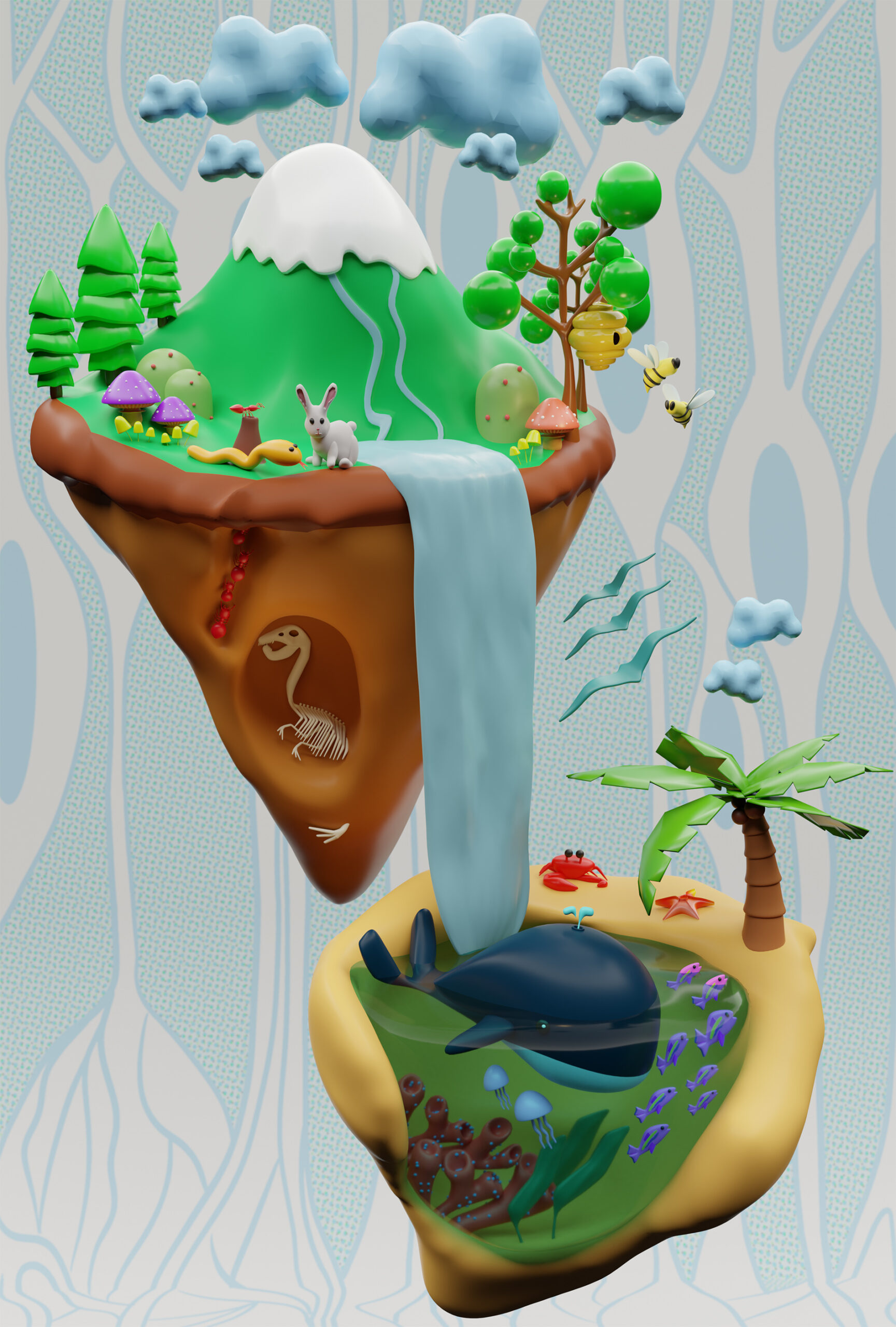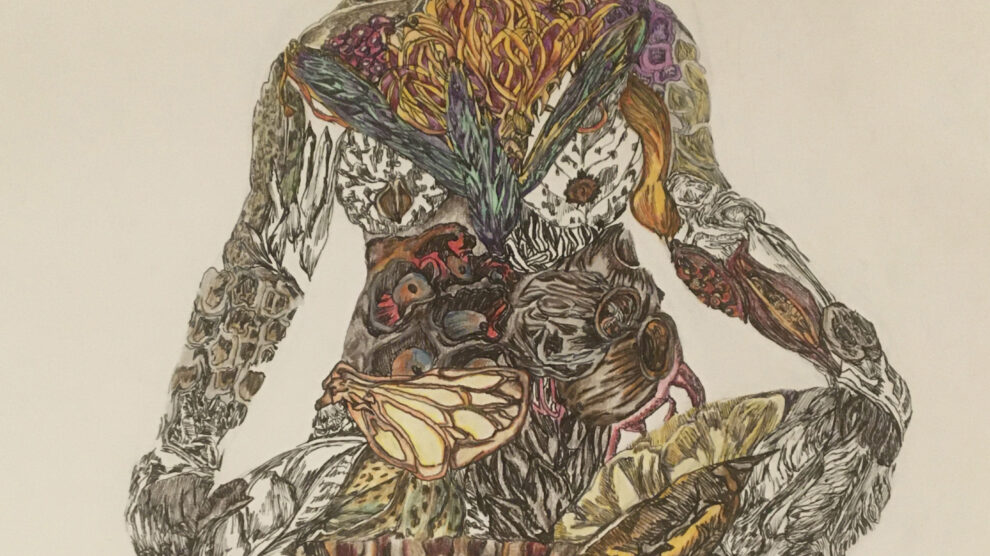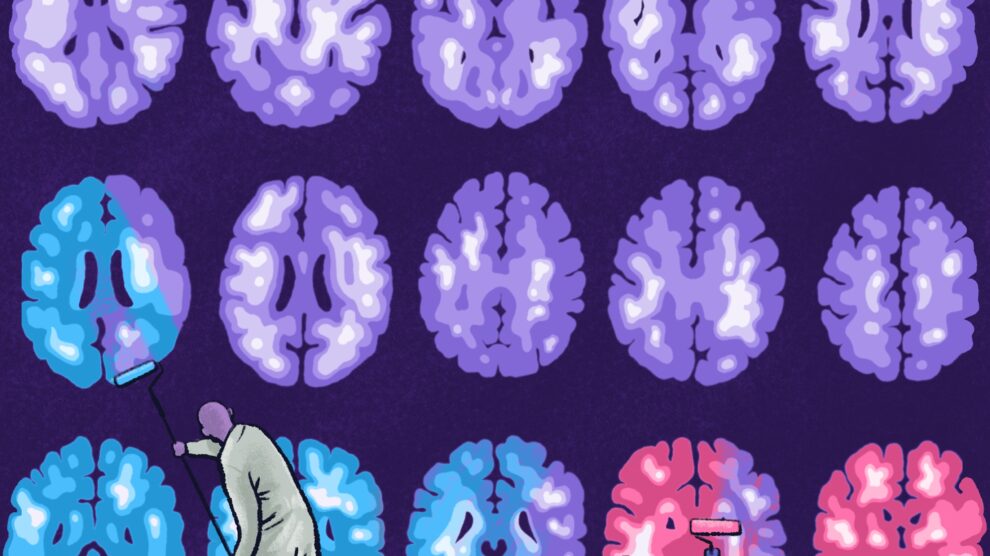Cooperation in Animals, and What It Tells Us about Scientists
By Caio Maximino and Marta Soares
Volume 24, no. 3, Cooperation: Theory and Practice for the Commons
Leia a tradução desse texto em português.

Cooperation is Everywhere
Cattle egrets pick harmful insects from water buffaloes and help alert them to danger. Meat ants use swarming tactics to protect their nests as well as their caterpillar neighbors. Ostriches and zebras team up in packs for added protection from predators. Ravens guide wolves to prey. Cleaner fish receive and inspect dozens of other fish in coral reefs. While it is often claimed that life boils down to survival of the fittest, nature is full of examples of animals cooperating with one another.
Cooperation—a widespread phenomenon that has fascinated biologists for centuries—refers to mutually beneficial interactions that occur among individuals of the same species or between different species.1 A generalized conception of evolution that normalizes competition as a major mechanism casts cooperation as a paradox, a piece in a puzzle where survival is measured in terms of costs and benefits, following the market rule of self-maximization. How could cooperation lead to any sort of evolutionary stability in a world made of blind, fearful competition, of “nature red in tooth and claw” (as the poet Lord Tennyson put it), or “survival of the fittest”?
These ideas about competition, however, were not actually introduced by Darwin, but rather by Darwinists who tried to expand his ideas to a kind of hypercompetitive evolutionary biology in order to justify laissez-faire economic policies, liberalism, imperialism, and eugenics. The anarchist Pyotr Kropotkin wrote Mutual Aid in 1902 as a response to these hypercompetitive interpretations, reacting to the assumption that nature is ultimately constitutive of “selfish” actors.2 Much later, David Graeber and Andrej Grubačić argued that the focus on competition in evolution was “an attempt to catapult the view of the commercial classes into universality.”3
Scientists are returning to the idea that cooperative behavior is both prevalent and diverse, which goes beyond the boundaries of genetic familiality—animals cooperate among kin and strangers alike, or even across different species and forms of life.4 Cooperative behavior can take on many forms. It can be aggressive (e.g., when individuals coordinate territorial defense), sexual (egg trading in simultaneously hermaphroditic coral-reef fishes), associated with parental investment (food provisioning by parents5), or even related to foraging (joint hunting). Moreover, these behaviors may be directed to a mate or a third party, and may be seen individually or collectively. Our objective here is not to enumerate the many forms of cooperation that occur; nor are we aiming to classify, define, or even validate all the diversity of forms or occurrences. It is also not our intention to assert that encounters between individuals in nature are always harmonious and idyllic, disregarding the role of competition or conflict. What we are doing here is putting competition and cooperation on equal footing, as Kropotkin did before us—as opposed to the general one-sidedness in evolutionary biology from which the popular understanding of evolution is based.
Despite the ubiquity of competition, nature is inherently cooperative.
Animals’ social lives are both competitive and cooperative. For instance, animals may establish privileged relationships (couple bonds, friendships, alliances) with specific partners who are treated differently from others, which contributes to generalized variation in behavior.6 This is the case with the Indo-Pacific cleaner wrasse, often found in mixed-sex pairs. These fish remove ectoparasites, dead or damaged tissue from visiting reef fish from other species (known as clients).7 Interestingly, the quality of their “cleaning service” is very much dependent on the quality of their “marriage,” as both fish need to restrain from conflict in order to attract and maintain the client in their territory (known as “cleaning stations”).8 To try to “appease” unruly clients, cleaners sometimes provide tactile stimulation (“massages”) that reduce hormonal stress responses in clients and make it easier for clients to restrain from chasing and eating the cleaner.9 Cleaners can also “cheat” by eating mucus instead of ectoparasites; whenever clients discover this, they may chase the “cheating” cleaners away, punishing them or simply swimming away never to return. Male and female cleaners can have relatively better or worse relationships, cleaning and providing massages to each other more or less frequently; but only males can punish (e.g., chase) females, thus controlling the females’ feeding behavior. Moreover, dominant female cleaners may eventually change sex to become males following the loss of the previous “harem male.” In such cases new “marriages” must be made, which will change the levels of conflict within couples and between cleaners and putative fish clients.10 Who would have guessed that interactions between fish would be filled with massages, punishment, complex social interactions, memory of past events, and behavioral restraint!
Another classic example of cooperative behavior is exhibited by bees, famous for living in societies that include high forms of communication, division of “labor,” complex nest construction, defense alliances, and environmental control, which together seems to represent an intermediate step in the evolution from asocial to social living. Many other examples could also be mentioned here: amoebas, shrimp, birds (such as flamingos, starlings, or social weavers), zebras, African elephants, and, of course, primates. Given all of this, we dare say that despite the ubiquity of competition, nature is inherently cooperative.
How Are We Made to Cooperate?
What are the mechanisms underlying cooperative behavior? Are there neural networks or neurochemical cascades that trigger these altruistic tendencies? If we are made to compete (so says the dogma of much past research in evolutionary biology), are we also built to cooperate? For instance, is there a cooperative chemical, neurotransmitter, or hormone that triggers animals’ seemingly altruistic behaviors?
Achieving a better understanding of the neurobiology of cooperation is a major and ongoing task, as cooperative behavior is based on a tremendous diversity of physiological, hormonal, and neural processes. The endeavor involves what comparative neurobiologists Lauren O’Connell and Hans Hofmann refer to as the “social decision-making network,” a network of brain regions that are highly conserved across vertebrates. These regions include areas associated with social behaviors that are highly sensitive to sex hormones (e.g., testosterone, estrogen, progesterone) and neuropeptides (molecules used by neurons to communicate with one another), as well as areas generally thought to be involved in assessing the “motivational salience” of stimuli (e.g., desirability or aversiveness of a stimulus).11 These regions interact with one another in a larger network that is involved in social stimulus evaluation and social behavior. While studies of human cooperative decision-making may highlight the brain networks that underlie cooperative behavior, studies of similar networks in animal models could allow us to investigate specific neurochemical processes in greater detail. From cooperative fish, for example, we have learned that neuropeptides released under stress (such as arginine vasotocin and isotocin12) and neurotransmitters (such as serotonin and dopamine) are major modulators not only of the cooperative tendencies of cleaners, but are also released in the clients’ brains to change how they behave in the mutual cleaning situation.
These neurochemicals mediate other fundamental mechanisms, such as reproduction or social challenges (for instance, avoiding a competitor or a predator); but evidence suggests they similarly modulate cooperative functions. For example, neuropeptides such as vasotocin and isotocin can regulate the appraisal of risk, making it easier for cleaners to cooperate with clients, which are potential predators. Dopamine is also involved in the assessment of risk, but it is mostly known as a major mediator of reward, which in conjunction with memory allows for anticipation. Of course, when we try to predict the outcome of a cooperative or social encounter, expectations are not always confirmed. In an experiment on the role of this neurotransmitter in cleanerfish, blocking the action of dopamine led cleaners to provide more tactile stimulation (“massages”) to clients but also to stop foraging (e.g., mucus and ectoparasites), perhaps because no trigger or reward was allowed to occur.13
Serotonin is another strong mediator of human and mammalian social propensities following similar trends by making cleanerfish “hyper-social,” causing them to move more quickly from one client to the next. Serotonin has been associated with behavior under threat, and it also regulates cooperative responses in another fish species, the guppy. When guppies—a shoaling species—are faced with a predator, individuals sometimes leave the shoal to “inspect” the predator; this behavior is interpreted as cooperative because the inspecting fish is now at greater risk of being attacked. Serotonin makes it easier for guppies to inspect predators in that situation, probably by changing how the cooperating individuals appraise the threat.14 As researchers continue to study these amazing aquatic creatures, we believe that many findings may be translatable to species across the animal kingdom—bringing new light to the overall understanding of cooperation and its physiological mechanisms. Importantly, we now understand that cooperation requires multiple mediators to orchestrate the remarkable ability of humans and non-humans alike to react and adapt to dynamic environments.
What Can Animal Cooperation Tell Us About the Science of Evolution?
Considering the many examples of cooperation across the animal kingdom, and knowing that we have gained stronger notions about the neurobiology of cooperation, why do some biologists still insist that individualism and competition are the main drivers of evolution? Why do evolutionary arguments emphasizing competition over cooperation seem to be overused in scientific curricula at all levels, and to permeate the public understanding of science? One hint comes from the arguments of anthropologist Susan McKinnon. In criticizing attempts to deny the cultural origins of most human behavior, McKinnon argues that “scientific objectivity” found in sociobiology and evolutionary psychology is a fiction created by oversimplified analogies. This flaw stems from an overdependence on research with undergraduate student subjects, a paucity of experiences with diverse human cultures and languages, and a refusal to engage seriously with anthropological research.15 Of course these scientists are speaking from somewhere—that is, they have a standpoint from which to defend their views, and which ultimately determines their views. Indeed, philosophers of science such as Helen Longino and Donna Haraway have been arguing that all science comes from a standpoint (i.e., socially conditioned) for quite some time now.
As David Graeber and Andrej Grubačić suggested in their introduction to Kropotkin’s Mutual Aid, there were many ideological, political, and economic reasons for evolutionary biology to assume competition as the main motor of evolution—the ideologue’s “entire game” was “to find some reason, any reason, to continue to insist that even the most playful, loving, whimsical, heroically self-sacrificing, or sociable behavior is really selfish after all.”16 To combat this ideological lens, a radical biology must continuously provide evidence for the role of cooperation in evolution, and counter biased theories of competition and individualism.
This article is part of our Winter 2021 issue: Cooperation. We will gradually post articles online in the coming months. Subscribe or purchase this issue to get full access now.
Notes
- Lee Alan Dugatkin, Cooperation among Animals: An Evolutionary Perspective (Oxford University Press, 1997).
- Peter Kropotkin, Mutual Aid: An Illuminated Factor of Evolution (Oakland: PM Press, 2021).
- David Graeber and Andrej Grubačić, introduction to Mutual Aid: An Illuminated Factor of Evolution, by Pyotr Kropotkin (Oakland, CA: PM Press/Kairos, 2021).
- Robert Axelrod and William D. Hamilton, “The Evolution of Cooperation,” Science 211 (1981): 1390–139. https://www.science.org/doi/10.1126/science.7466396.
- Parents reduce their fitness to provide food for the offspring. This is not usually understood as cooperative, but from the point of view of most common fitness theories, reducing one’s own fitness to improve the fitness of another (including progeny) may be seen as cooperation.
- Marta C. Soares et al., “Hormonal Mechanisms of Cooperative Behaviour,” Philosophical Transactions of the Royal Society B: Biological Sciences 365, no. 1553 (2010): 2737–50, https://doi.org/10.1098/rstb.2010.0151.
- Isabelle M. Côté, “Evolution and Ecology of Cleaning Symbiosis in the Sea,” Oceanography and Marine Biology 38 (2000): 311–355.
- Marta C. Soares, “The Neurobiology of Mutualistic Behavior: The Cleanerfish Swims into the Spotlight,” Frontiers in Behavioral Neuroscience 11 (2017): 191, https://doi.org/10.3389/fnbeh.2017.00191.
- Marta C. Soares et al., “Tactile Stimulation Lowers Stress in Fish,” Nature Communications 2 (2011): 534, https://doi.org/10.1038/ncomms1547.
- These individuals have the striking ability to change sex bidirectionally if socially or environmentally needed. See also D. Ross Robertson, “Social Control of Sex Reversal in a Coral-Reef Fish,” Science 177 (1972): 1007–9, https://doi.org/10.1126/science.177.4053.1007; Yoichi Sakai, Masanori Kohda, and Tetsuo Kuwamura, “Effect of Changing Harem on Timing of Sex Change in Female Cleaner Fish Labroides dimidiatus,” Animal Behavior 62 (2001): 251–257, https://doi.org/10.1006/anbe.2001.1761.
- Lauren A. O’Connell and Hans A. Hofmann, “Evolution of a Vertebrate Social Decision-Making Network,” Science 336, no. 6085 (2012): 1154–7, https://doi.org/10.1126/science.1218889.
- Vasotocin and isotocin are akin to mammalian vasopressin and oxytocin—molecules that are commonly associated with social behavior.
- Soares, “The Neurobiology of Mutualistic Behavior.”
- Ana Flávia Nogueira Pimentel et al., “Conditional Approach as Cooperation in Predator Inspection: A Role for Serotonin?,” Behavioural Brain Research 365 (2019): 164–69, https://doi.org/10.1016/j.bbr.2019.03.005.
- Susan McKinnon, Neo-Liberal Genetics: The Myths and Moral Tales of Evolutionary Psychology (Chicago: Prickly Paradigm Press, 2005).
- Graeber and Grubačić, introduction to Mutual Aid.





